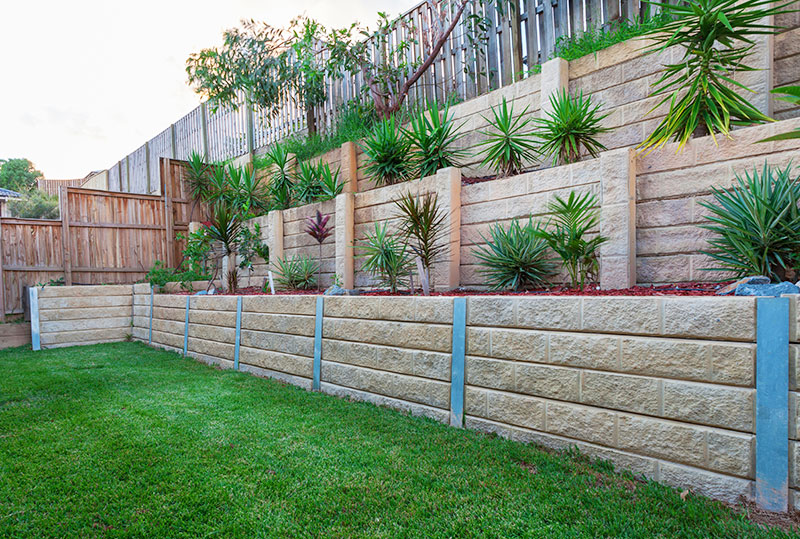
The Historical Significance of Stone in Construction
Stone has been a cornerstone of construction since ancient times. In Australia, Indigenous cultures have used stone for tools and structures, while European settlers brought with them the techniques of stone masonry, adapting them to the local environment.
From Ancient Times to Modern Landscaping: A Brief History
The history of stone walls in human civilization spans from the ancient pyramids of Egypt to the sprawling Roman Empire and now to modern Australian landscaping. Their evolution reflects changes in both aesthetic tastes and functional needs.
The Evolution of Stone-Retaining Wall Designs
Originally, stone walls were primarily functional and used for boundaries or fortification. Today, in places like Melbourne and Adelaide, they are also designed for aesthetic appeal, often incorporated into garden designs and public spaces.
Critical Benefits of Stone Retaining Walls
Durability and Longevity: The Hallmarks of Stone Walls
In the harsh Australian climate, the durability of stone-retaining walls is unmatched. They withstand extreme weather, from the scorching summers to the wet winters, making them a practical choice for long-term landscaping solutions.
Natural Aesthetics and Versatility in Design
The natural appearance of stone walls can enhance any landscape design. Whether it’s the rustic charm in a Tasmanian country home or the sleek, modern lines in a Brisbane backyard, stone walls offer immense versatility.
Blending with Various Landscapes and Architectural Styles
Stone walls can be designed to complement various architectural styles across Australia; from Victorian to contemporary, they fit effortlessly into any setting.
Stone Retaining Walls: A Sustainable and Eco-friendly Choice
As a natural and abundant material, Stone is a sustainable choice for environmentally conscious Australians. Using local Stone can also reduce the environmental impact associated with transportation.
Design Principles for Stone Retaining Walls
Primary Design Considerations for Stability and Strength
Designing a stone wall requires understanding the soil type, drainage, and load-bearing requirements, especially in regions prone to soil movement, like those in parts of New South Wales.
Creative and Aesthetic Aspects in Stone Wall Design
The aesthetic design must blend functionality with style. This includes choosing the right stone type, colour, and construction technique to match the landscape and architectural style of the surrounding area.
Incorporating Stone Walls into Different Landscape Themes
Stone walls can be tailored to various landscape themes, from a native bush garden in Western Australia to a formal, structured garden in Canberra.
Innovative Design Trends in Stone Retaining Walls
Recent trends in Australia include integrating LED lighting and water features or using recycled stones for an eco-friendly and unique appearance.
Types of Stones for Retaining Walls
An Overview of Commonly Used Stone Types
In Australia, commonly used stones include sandstone, bluestone, and limestone, each offering different textures and colours.
Characteristics and Benefits of Various Stone Materials
Each stone type has unique characteristics. Sandstone, with its warm colours, is famous in Queensland, while bluestone is a staple in Melbourne due to its durability and distinct appearance.
Regional Stone Varieties and Their Unique Qualities
Australia’s diverse geology offers a range of regional stones. For example, the Kimberley region is known for its unique sandstone, while Tasmania’s dolerite is renowned for its strength.
Comparing Cost and Availability of Stone Types
The article would delve into the cost-effectiveness and availability of different stone types across Australia, offering practical advice for potential builders.
Installation and Maintenance of Stone Retaining Walls
Step-by-Step Guide to Building a Stone-Retaining Wall
Building a stone retaining wall in Australia involves several key steps:
- Selecting the appropriate Stone
- Preparing the foundation
- Laying the stones carefully
- Ensuring proper drainage
This section will provide a detailed guide suitable for both professionals and keen DIY enthusiasts.
Essential Maintenance Tips for Longevity and Aesthetics
While stone walls are low-maintenance, regular checks and minor repairs can extend their life and preserve their beauty. This includes checking for and rectifying any movement or erosion, particularly after extreme weather events common in areas like Queensland’s tropical north.
Addressing Common Issues and Repairs in Stone Walls
Common issues such as loose stones, water damage, or moss growth require specific repair strategies. This part of the article will provide practical advice on addressing these issues and ensuring the wall remains functional and visually appealing.
Professional vs. DIY: What You Need to Know
The decision between hiring a professional and undertaking a DIY project depends on factors like the design’s complexity, the project’s scale, and the individual’s skill level. This section will compare the two approaches, highlighting the pros and cons of each.
Get In Touch Today
To learn more about our range of stone retaining wall services, contact our team. Give us a call today, and we’ll help you make the right choice based on your requirements. Reach out to our friendly team today and get free quotes.
